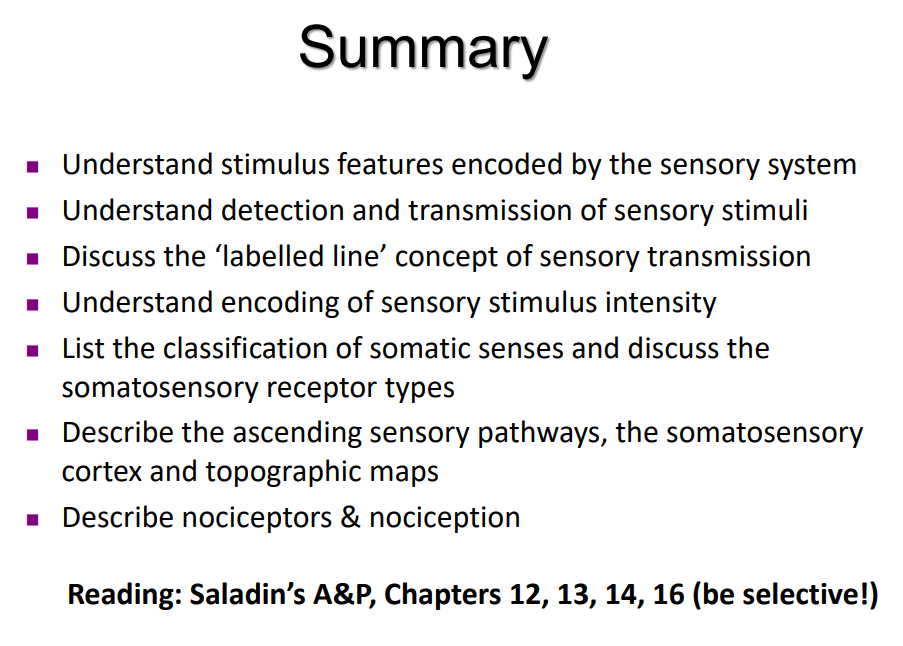IMED1001 - Sensory Physiology (Week 5)
1/31
There's no tags or description
Looks like no tags are added yet.
Name | Mastery | Learn | Test | Matching | Spaced |
|---|
No study sessions yet.
32 Terms

Generalised Sensory Pathway
DIAGRAM ON SLIDE 3

Proprioception
our sense of body position
Stimulus Features Encoded by Sensory Systems
- Modality: types of modality are: light, sound, touch, pain, heat, cold, smell, taste, sense of limb position
- Spatial Information: body location for touch and pain, location in external space for light and sound (can easily tell if someone touched right or left ear)
- Intensity: threshold (the minimum detectable intensity), perceived strength above threshold (can tell a strong stimulus from weak stimulus)
- Quality: e.g colour, sharpness of pain, pitch of sound. etc
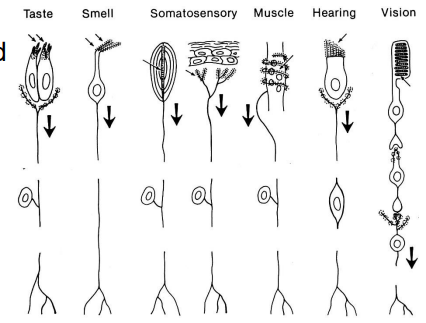
Modality
- What forms of stimulus can actually be detected?
1. Mechanical - sense of touch, limb position, hearing, balance etc.
2. Chemical - taste, smell
3. Photic - vision
4. Thermal - sense of hot and cold
5. Noxious - pain
Has specific receptors
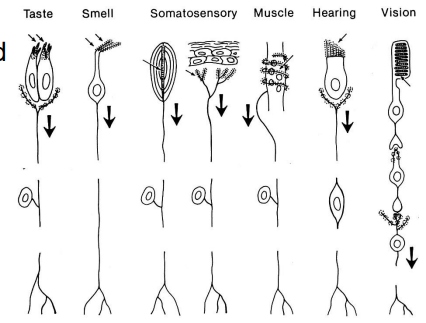
Classes of Sensory Receptors (5 major divisions)
based on stimuli they respond to:
1. Mechanoreceptors
2. Thermoreceptors
3. Photoreceptors
4. Chemoreceptors
5. Nocireceptors
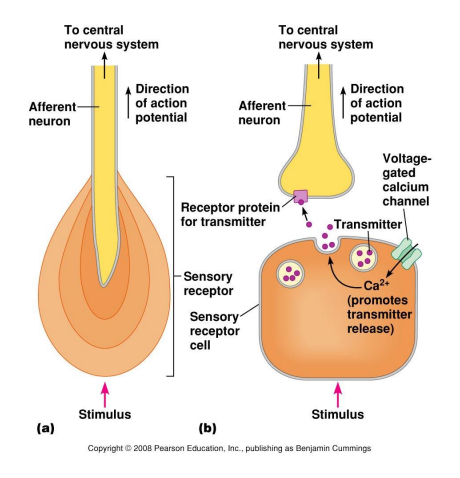
Sensory Transduction (conversion)
- Sensory receptors are specialised cells that generate graded potentials called receptor potentials in response to a stimulus
- Two types of receptor cells: a nerve cell, specialised cell + afferent neuron
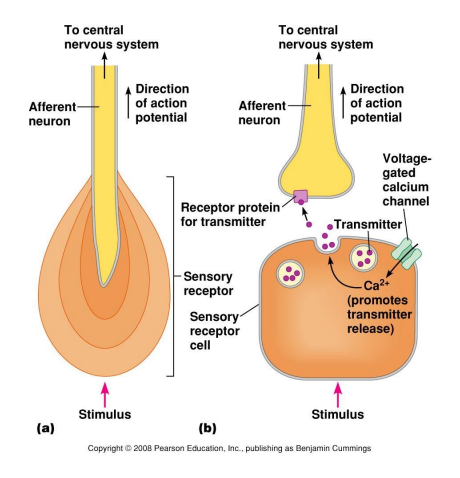
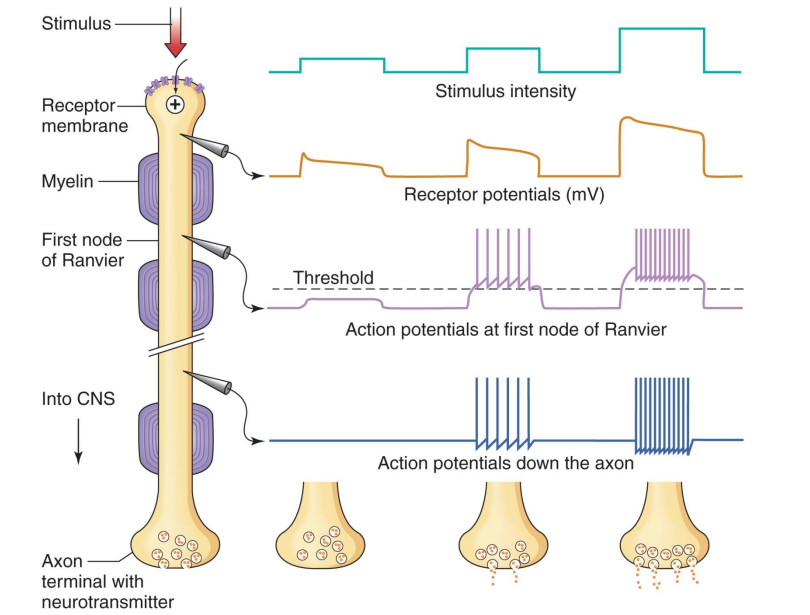
Receptor Potential
- dictated by how strong stimulus was in the first place
stronger stimulus will stimulate a greater number of action potentials per second


Stimulus Intensity
- encoded by the frequency of action potentials
- greater stimulus intensity = greater afferent firing rate
- very weak stimuli wont reach threshold (no AP)
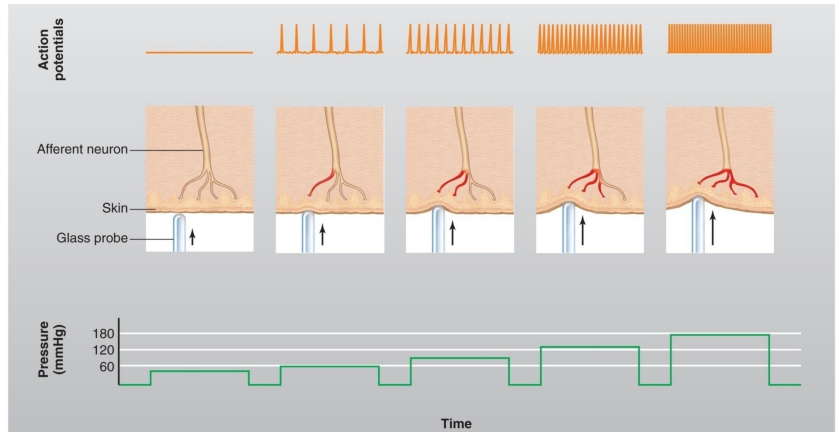

Stimulus Duration: Rapid vs Slow Adaptation
- Rapid Adapting neurons respond poorly to steady stimuli, but very well to dynamic stimuli. (takes 2-3 seconds to adapt)
- Slow adapting neurons detect continuous stimuli, but not dynamic stimuli. (gives steady state)
- good example: when you sit on a chair, you initially feel the chair (nerves detect it). Over time, you become adapted to it and you stop to feel the sensation of the chair
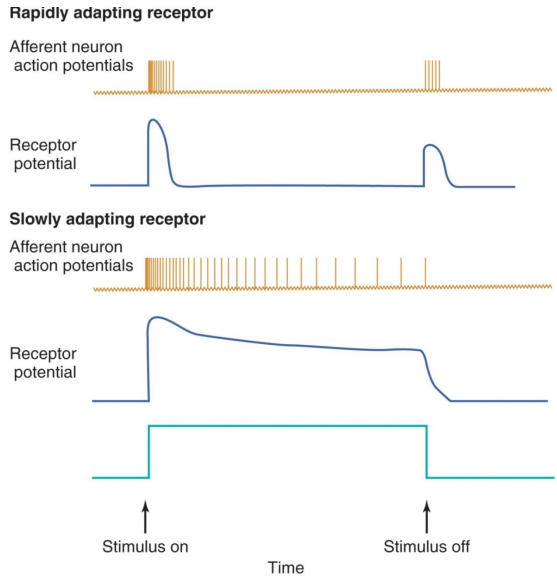
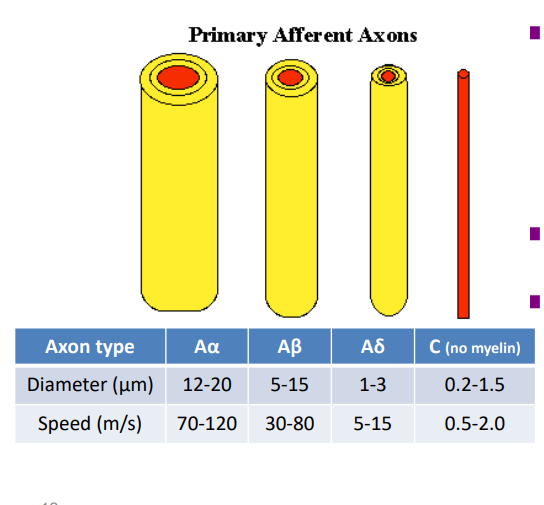
Stimulus Rapidity: Fast vs Slow Transmission
- first order neuron determines whether conduction may be fast or slow
- C fibres = slow
- Aa (second letter is supposed to be alpha) = super fast
- lots of myelin means faster transmission
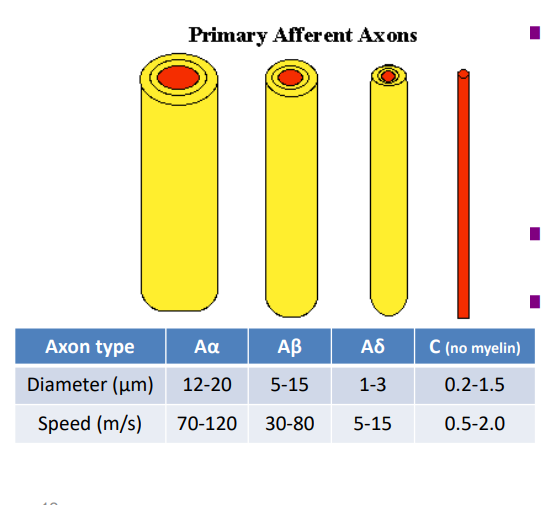

Stimulus Acuity (sharpness/precision). Receptor Field and Lateral Inhibition
- ability to distinguish between two spatially separate stimuli (a sharp/precise 'image')
- Depends on: density of peripheral receptors, size of receptive fields, central convergence and lateral inhibition
- low acuity: you know the area of the touch, but its not precise. large receptive field
- high acuity: you know the precise location of touch. low receptive field
- convergence allows us to use a small part of spinal cord to survey a large area of skin (look at bottom right diagram, where large area of skin is taken and stimuli processed by small part of spinal cord). gives large receptive field
- fingers have high acuity, eyeballs are high acuity
lateral inhibition is the ability of a neuron to inhibit surrounding neurons from firing when it itself fires

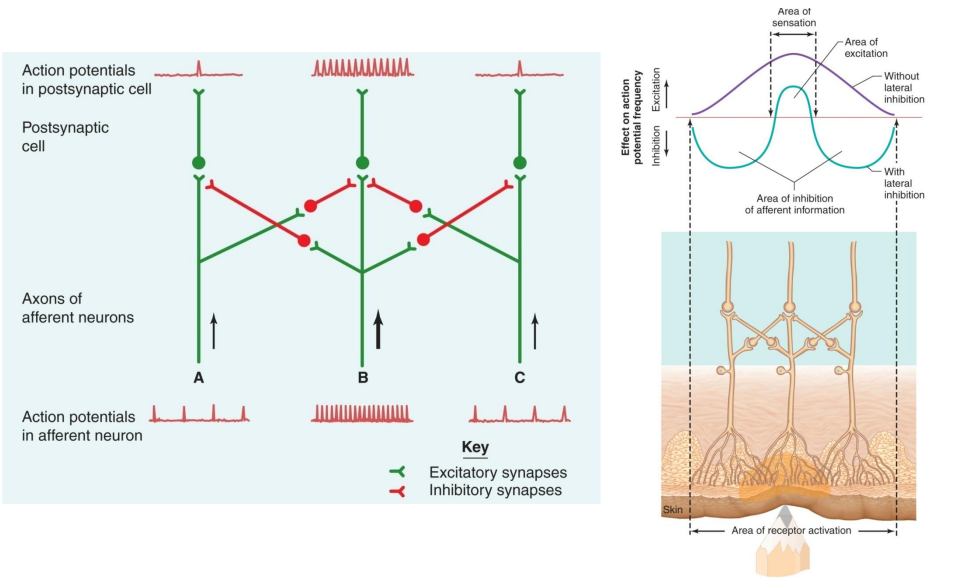
Lateral Inhibition restricts spatial spread of excitation
- only main point of contact in touch is filtered through. Weaker stimuli at the site of reception are detected but cut out
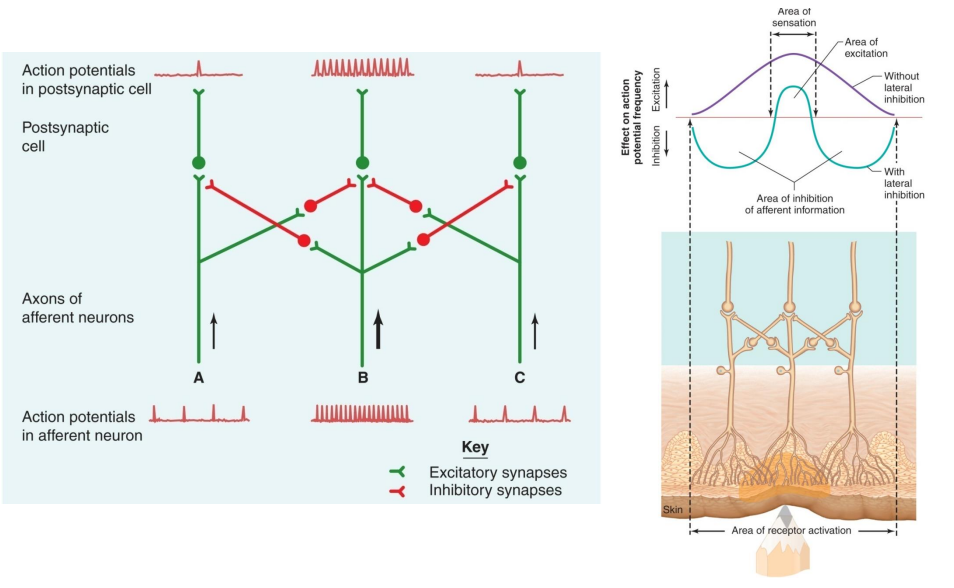

Stimulus Modality and Spatial Location? Encoded by Labelled Lines
- each sensory nerve fibre transmits only one modality of sensation to a specific location. (receptor does not dictate what the brain will understand, the location of the afferent nerve does. Called the labelled line principle)
- Action potentials in labelled lines generate specific sensory preception.
- if a pain fibre is stimulated, you will perceive pain no matter what type of stimulus excites the fibre
- we have areas responsible for vision, hearing, touch etc. it doesn't matter how you send pathway, its the location that matters.
The labeled line principle states that sensory signals travel along specific, dedicated neural pathways to the brain, ensuring that a particular type of sensory input (e.g., touch, temperature, taste) is consistently and accurately perceived. Each sensory receptor and its corresponding neural pathway is "labeled" for a specific sensory modality
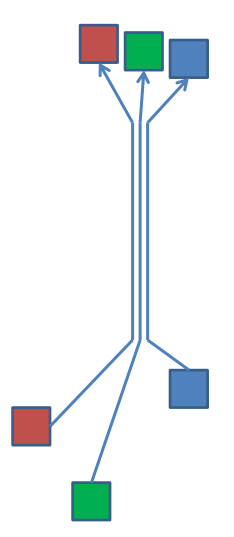
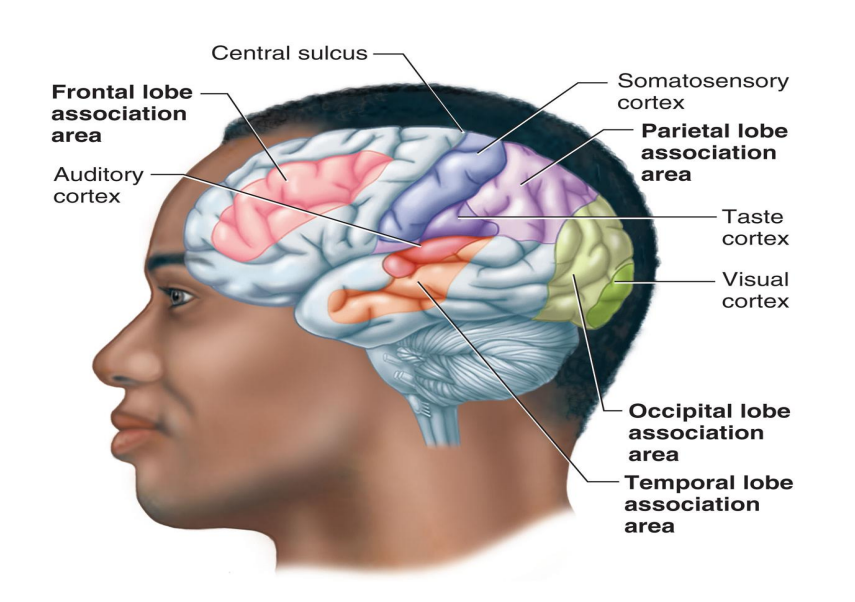
Sensory Areas of the Cortex
DIAGRAM ON SLIDE 16
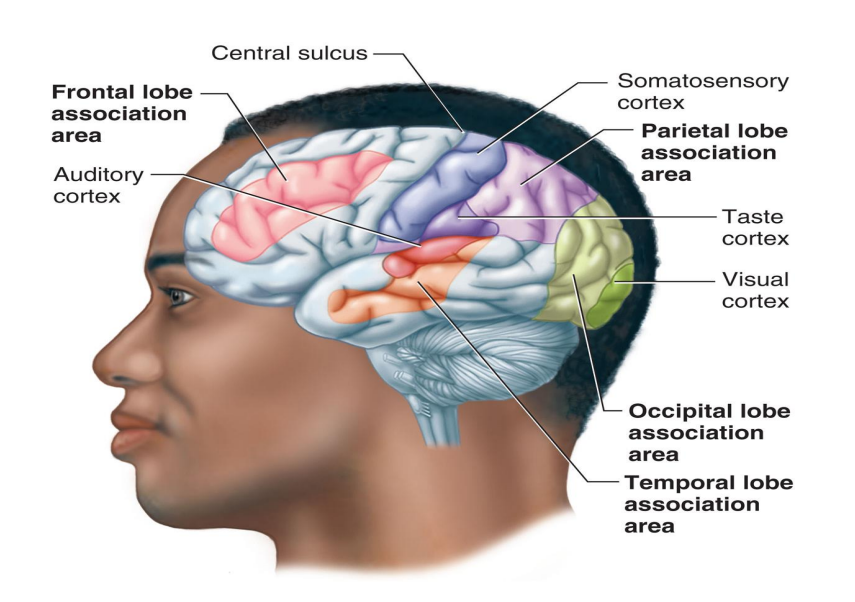
Somatosensory System
'somato' just means body
Somatic Sensation
- sensation from skin, muscles, bones, tendons and joints
- tactile sense (touch, pressure, vibration, tickle)
- temperature (warm, cold)
- propriocept (static position, rate of movement, ability to tell how long muscles are)
- noxious sensation (pain)
- initiated by a variety of somatic receptors (mechanoreceptors, thermoreceptors, nociceptors)
Sensory Receptors in Skin
- free nerve endings (pain, warm, cold) (rapidly and slowly adapting, variable gating, A delta or C fibres)
- Touch Receptors (deep RA + SA, shallow RA + SA (Slow adapating)
DEEP: (heavy pressure on skin)
- Lamellar (Pacinian) corpuscle (rapidly adapting mechanosensor) (deep pressure, vibration, A beta fibres)
- Bulbous (Ruffini's) corpuscle (slowly adapting mechanosensor) (heavy touch, stretch (joints), A beta fibres)
SHALLOW: (light touch on skin)
- Tactile (Meissner's) corpuscle (rapidly adapting mechanosensor) (altered light touch, spatial characteristics, A beta fibres)
- Tactile (Merkel's) Disks (slowly adapting, mechanosensor). (continuous light touch (steady state info) (A beta fibres)
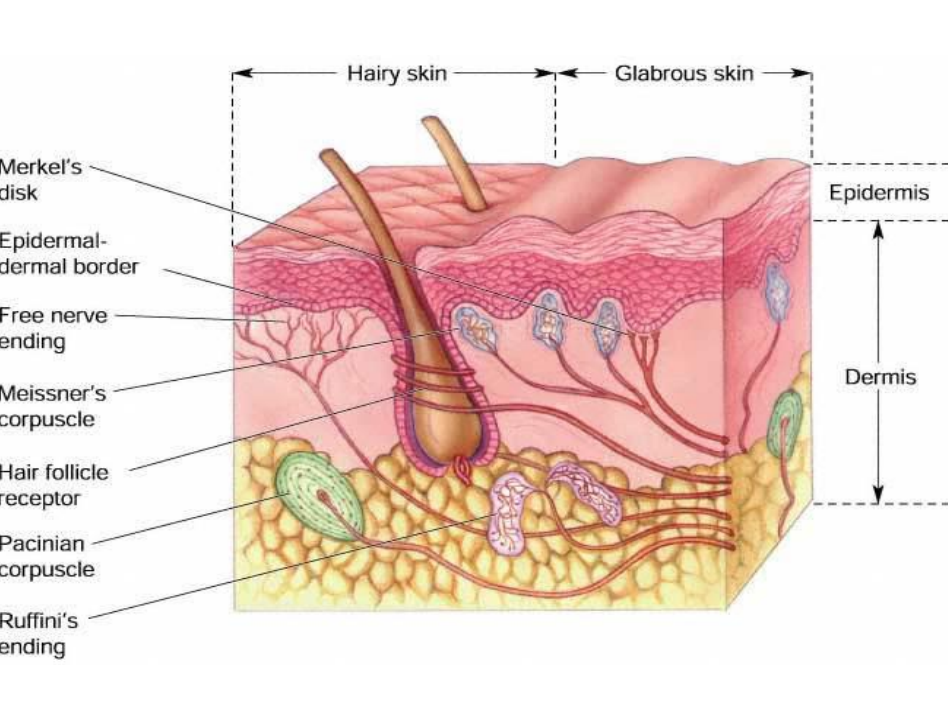
DIAGRAM OF SENSORY RECEPTORS IN SKIN
DIAGRAM ON SLIDE 20
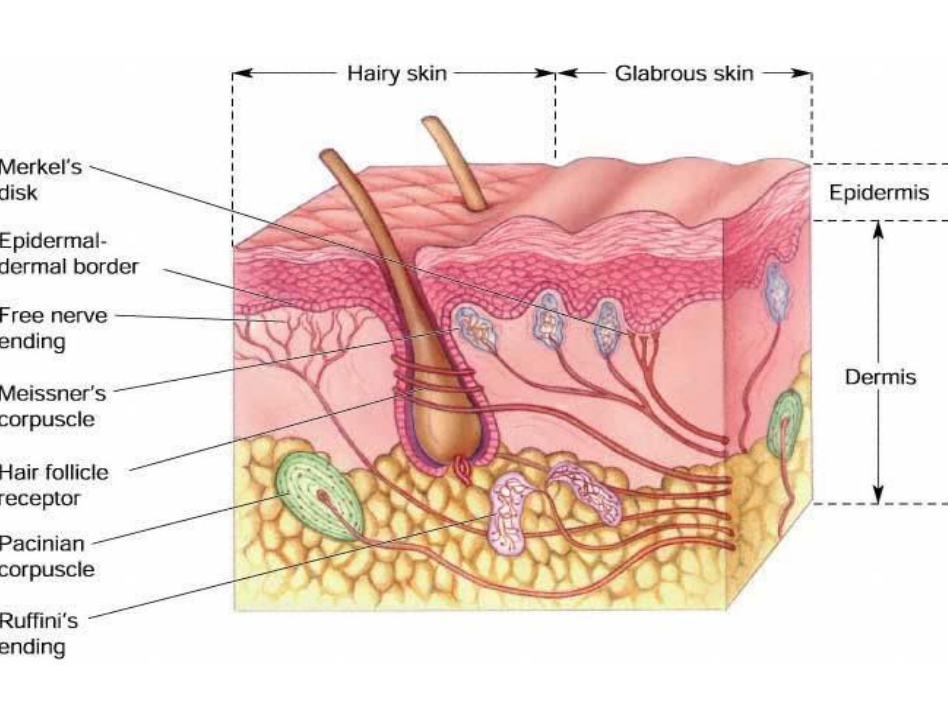
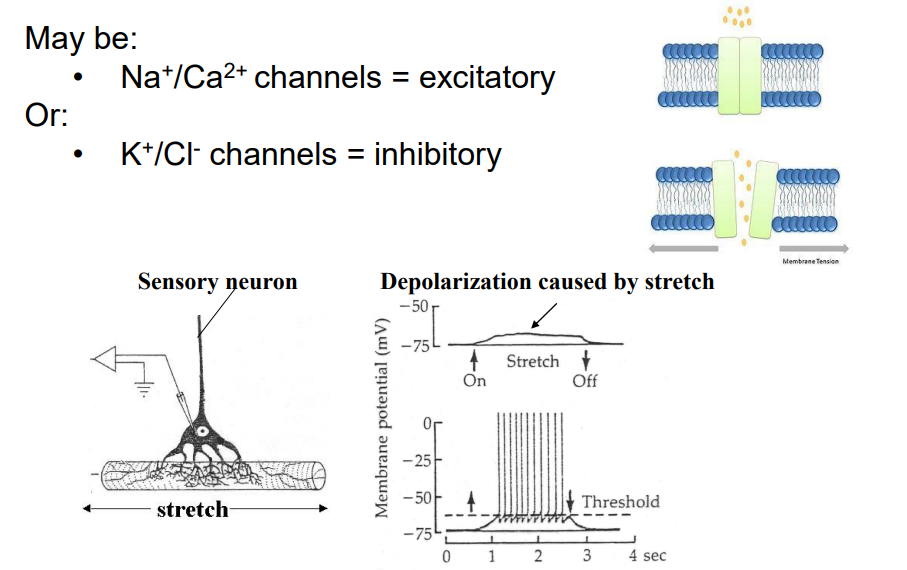
Mechanosensitive Neurons have Stretch-gated ion channels
- May be: Na+/Ca2+ channels = excitatory
- K+/Cl- channels = inhibitory
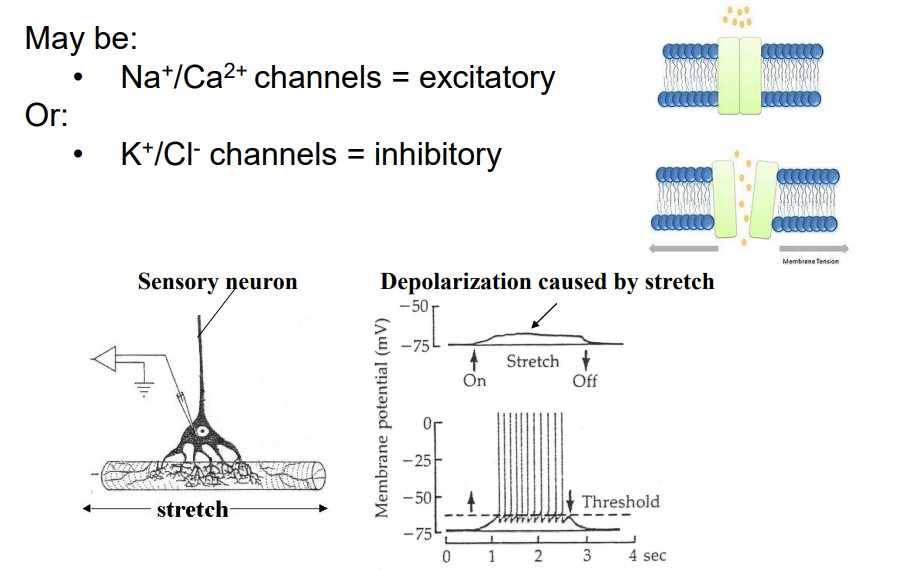
Sensory Receptors - Positional sense
GOLGI TENDON ORGANS
- tension
- slowly adapting A alpha or A beta fibres
- Joint position, reflex response to over-flexion
MUSCLE SPINDLES
- muscle length, stretch
- rapid adapt or slowly adapt, A alpha or A beta fibres
- rate of length change and muscle stretch
ALSO JOINT CAPSULE RECEPTORS
- Ruffini's mechanoreceptors in joint capsule
- Provide joint angle information
sensitive to stretch
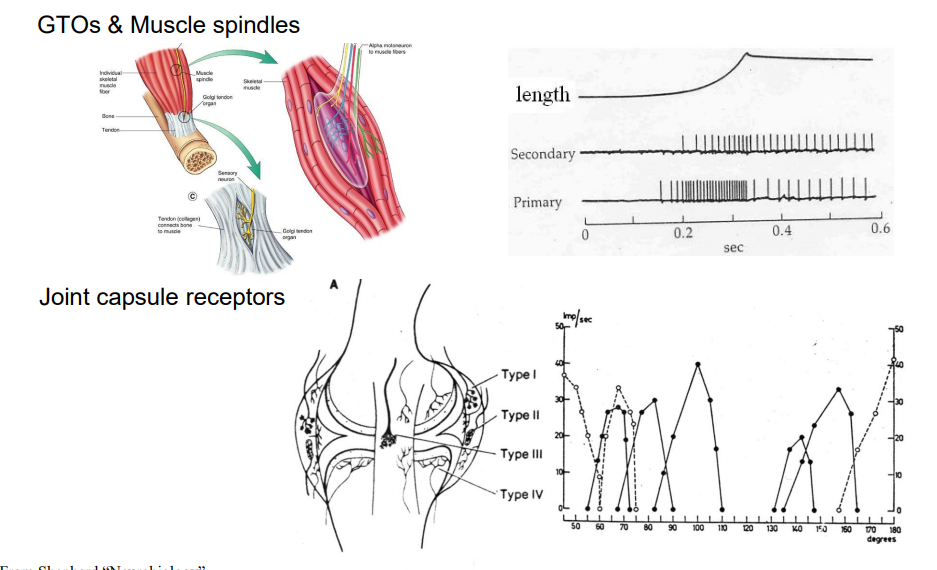
Sensory Afferents in Joints Signal Joint Angle
DIAGRAM ON SLIDE 23
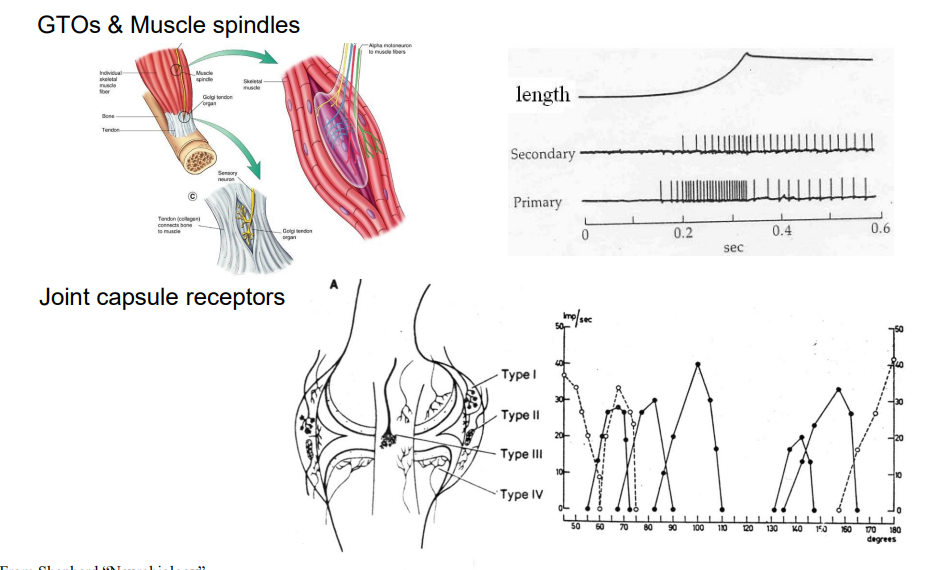
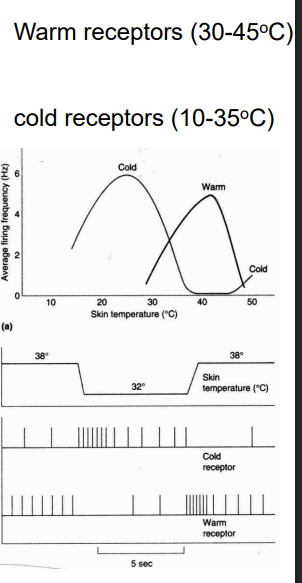
Thermoreceptors - separate cold and warm
- transient receptor potential (TRP) channels are temperature-sensitive ion channels (excitatory Na+/Ca2+ channels)
- Cold receptors: TRPM8 channels (firing rate increases as temp decreases, temp range spanning about 10-35C, also respond to menthol, eucalyptus oil) (M stands for menthol) (since firing rate increases as temp drops this is why a lower temp is more significant)
- Warm receptors: TRPV1/3 channels: firing rate increases as temp increases (TRPV3 = 22-40C, TRPV1 = 42C+) (V stands for Vanilla) (since firing rate increases as temp increases this shows that higher temp is more significant)
transient means it only lasts for a short time
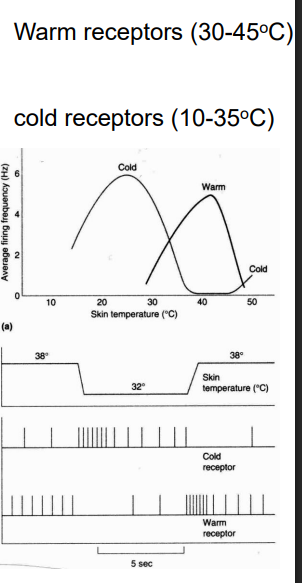
The somatosensory system has
2 distinct afferent pathways
Distinct Afferent Pathways of the Somatosensory System
- Dorsal Column-Medial Lemniscal Pathway (DCML)
- Anterolateral Pathway (AP)
Functional Differences between DC-ML and AL System (speed of fibres, spatial organisation, some functions)
DC-ML SYSTEM:
- fast fibres (30-110 m/s)
- more spatial organisation
- localised touch, fine grade touch, vibration, movement against skin, joint position, fine pressure (all things that need to be rapid)
AL SYSTEM:
- slow fibres (less then 40m/s)
- less spatial organisation
- pain, heat and cold, crude touch, crude pressure, tickle and itch, sexual sensation (things that dont need to be rapid)
When it comes to the brain, the most important thing is
its where it goes thats important

Topographic Mapping in the Somatosensory Cortex
DIAGRAM ON SLIDE 28
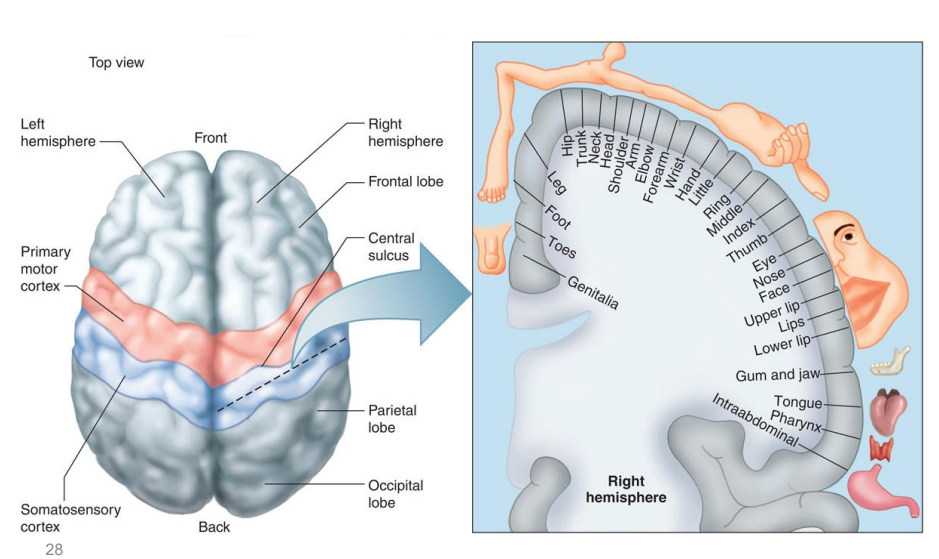
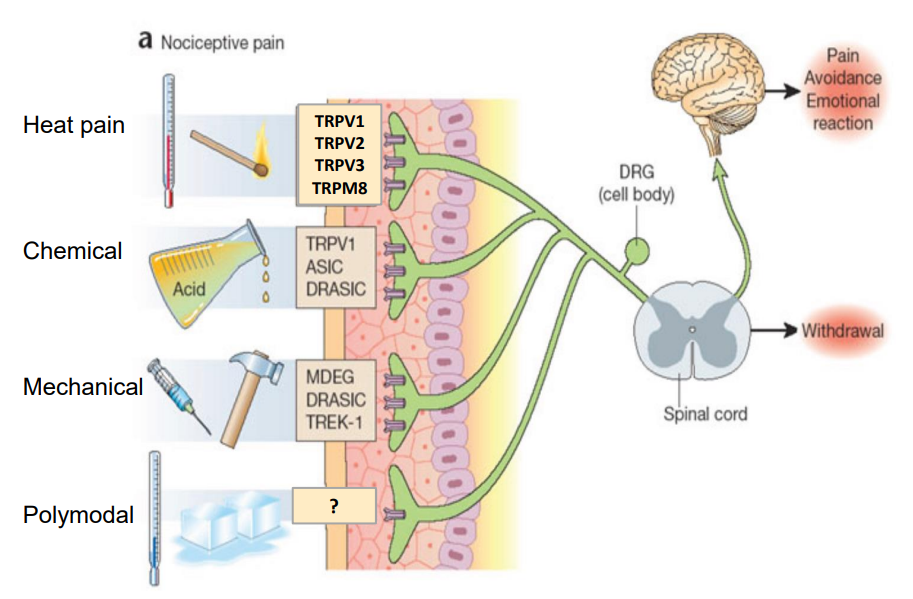
Pain Summary
- Types: heat pain, chemical pain, mechanical pain, polymodal pain
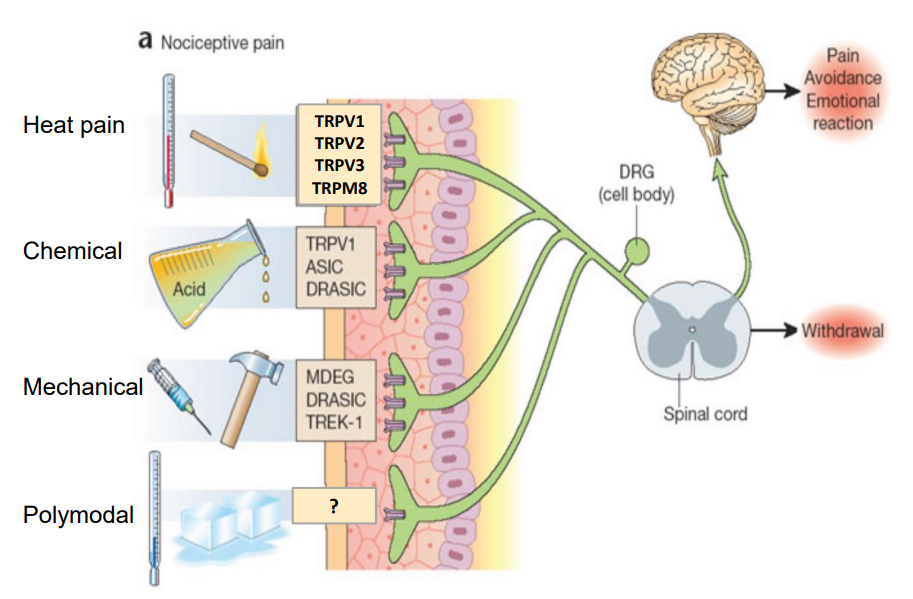
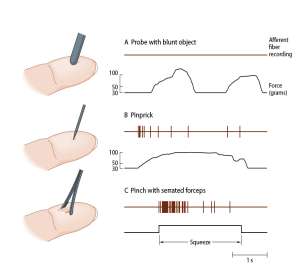
Mech/temp nociceptors
mechanical pain (prick, pinch):
- strong pressure/pinch/squeeze (high threshold stretch-gated Na+/Ca2+ channels)
- Mediate pain from skeletal muscle or viscera due to excessive stretch or contractile force
Temperature Pain (hot, cold):
- Thermally-gated ion channels
- TRPV1/3 (HOT) and TRPM8 (COLD) Channels
- The brain perceives these signals as pain, even though they are elicited by the same types of channels
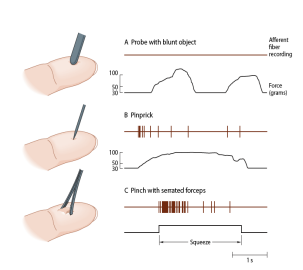
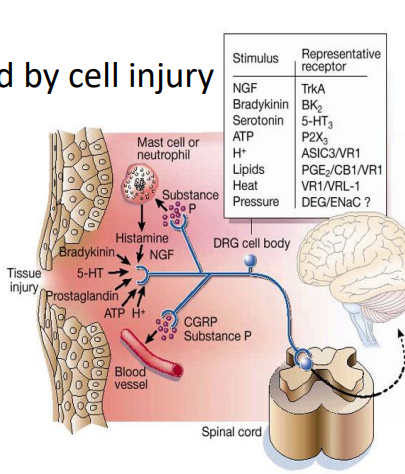
Chemical Nociceptors
- exogenous chemicals that penetrate skin (acid, alkali, organic molecules (e.g capsaicin, mustard oil))
- intracellular moleules released by cell injury (cations K+ and H+, peptides, neurotransmitters, prostaglandins, histamine, bradykinin
- Toxins (micro-organisms, insect bites, venom)
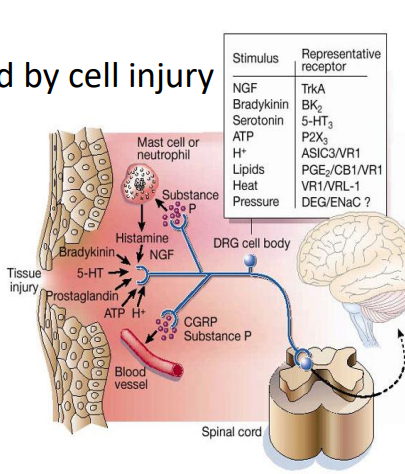
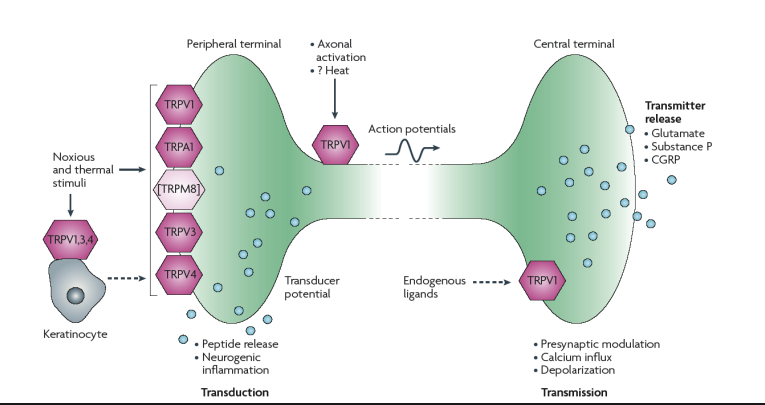
Polymodal Nociceptors
- receptive to all other painful stimuli
- respond to heat, cold, pinch, and chemical stimuli
- express multiple receptors
- high threshold, but sensitive to almost all types of stimuli
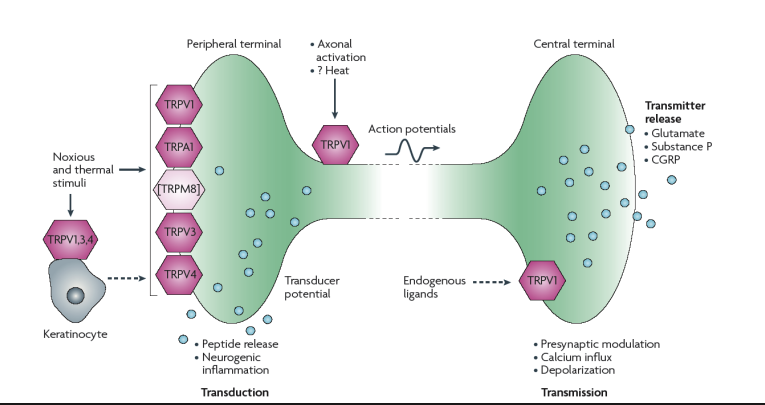
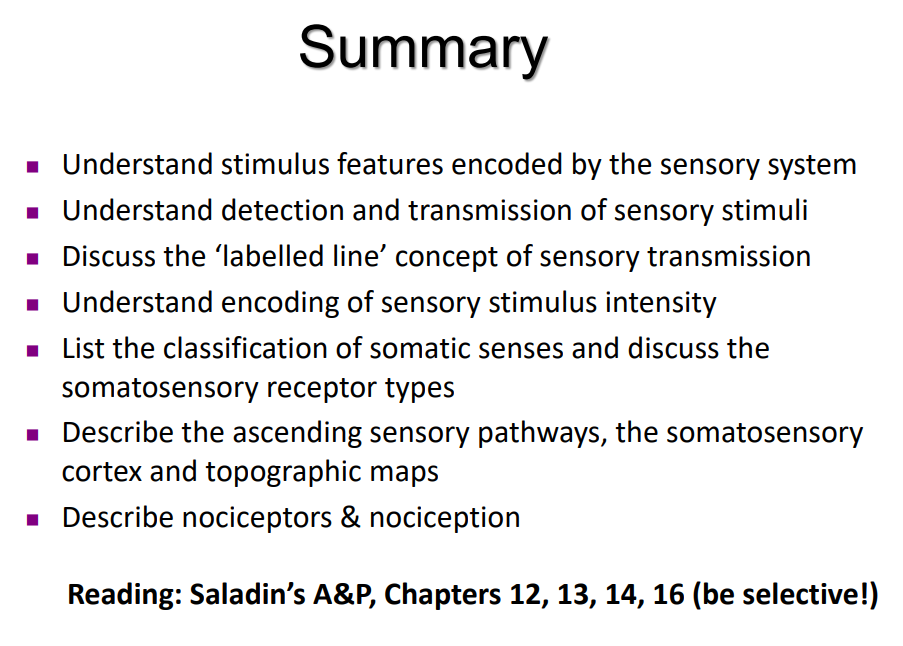
SUMMARY
DIAGRAM ON SLIDE 33
